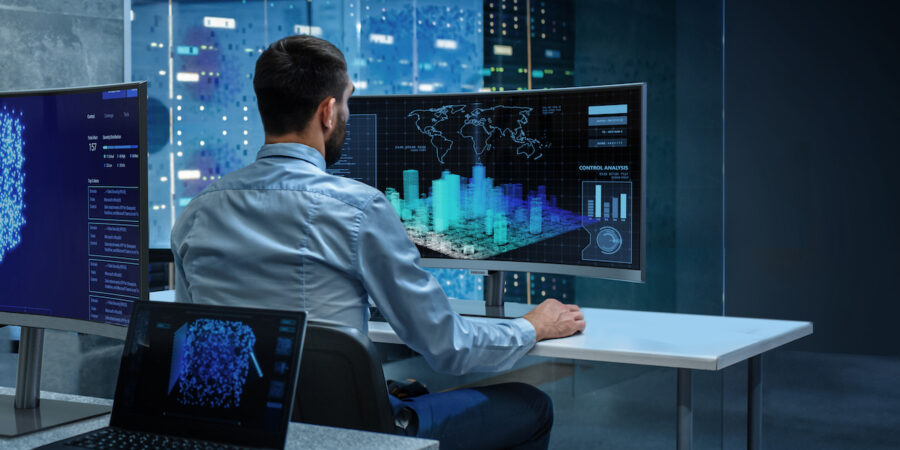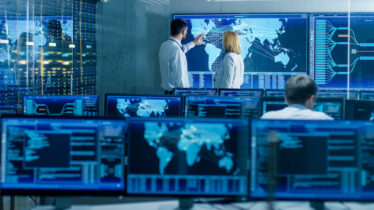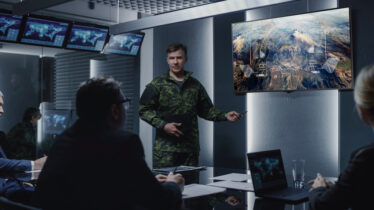The command center of any organization is its nerve center — the hub where data is analyzed and decisions are made. In military operations, command and control centers are essentially war rooms, where real-time data, audio and video inform a coordinated plan of action.
These rooms are also used for dispatch and surveillance monitoring. The National Military Command Center (NMCC), for example, is responsible for analyzing data and generating Emergency Action Messages (EAMs) for everything from reconnaissance aircraft to battlefield commanders across the globe.
To do their jobs, the technicians and analysts who work in command and control centers need intuitive, responsive and versatile equipment. That includes everything from computing devices to network connectivity.
Desktop monitors are a critical part of effective control rooms. Without high-quality video — to scale — and flexible controls, analysts can’t perform at the level their job demands.
Critical features for command center monitors
Command center workstations are crucial for analysts scrutinizing video footage, especially when processing sometimes grainy video from satellites, unmanned aircraft systems and intelligence reconnaissance systems. Analysts also need to account for radar sensors, infrared sensors, geospatial information and relevant statistical data. As such, they must use monitors that render as clear imagery and accurate colors as possible.
Secure your federal display technology
Get your free guide to the cybersecurity essentials for large-format displays in government agencies. Download Now
Valuable features for control room monitors include ultra-wide and curved screens, extremely high resolution, high dynamic range color technology and high refresh rate. The top Samsung high-resolution monitors fulfill these needs and make a great fit for command and control operations.
- S34A654UBN Ultra-WQHD. This 34-inch screen is curved to match the natural field of human eyesight. Its 21:9 aspect ratio gives command center operators plenty of room to open multiple windows and applications. The screen refresh rate of 100Hz makes pointing and clicking with a mouse smooth. USB-C connectivity boosts implementation flexibility.
- F32TU874VN 4K UHD Monitor. This flat 32-inch screen is designed for easy daisy-chaining in a dual-monitor setup. Two Thunderbolt ports make compatibility with Macs and PCs a snap. With 4K UHD resolution, analysts can count on picking up subtle details in video feeds and graphics.
- S49CG954SN Odyssey OLED. While this curved, ultra-wide 49-inch monitor was built for gamers, its massive screen, vivid colors and 110 PPI resolution make it an excellent fit for command center workstations. The OLED technology also has superior contrast ratio helping to pick up details in shadow areas more clearly.
These monitors provide more than visual functionality. They’re also optimized for professionals who work high-stress shifts in command centers.
All-day use
Analysts often stare into command center monitors for hours on end with few breaks. Extra-wide monitors, especially curved monitors, can reduce eye strain and help prevent upper body aches by equalizing the focal distance of the center and edges of the screen.
To further reduce eye strain, look for higher-resolution monitors and built-in eye-saver features that allow you to recalibrate the contrast, brightness and saturation settings. Advanced eye care technology in Samsung monitors also helps minimize blue light emissions with Eye Saver Mode, while Flicker Free continuously removes screen flicker.
Unmatched connectivity
It’s not uncommon for command center workstations to use multiple monitors at the same time, even if the monitors are widescreen. Connecting these monitors is much simpler with daisy chaining. A DisplayPort Out connection and just one cable per monitor allows as many as four screens to connect to a single PC.
Command center monitors also benefit from USB-C connections — which essentially turn a monitor into a docking station — able to connect data, video, audio and power all with one cable.
Security and compliance
Monitors don’t require the same security as other types of technology because they have no internal memory, but it still makes more sense to rely on monitors from vendors that put security first. Samsung protects its monitor users with an array of safeguards that ensure speed and accuracy and preemptively block security risk factors.
An investment that matters
Operators at command and control centers must make quick decisions based on a constant stream of information. The job is easier with versatile, flexible, vibrant command center monitors and workstations that can be configured to meet analysts’ specific needs.
Find out more about how integrating control room display solutions improves public safety. And discover the full lineup of Samsung desktop monitors to see which model best suits your business needs and your budget.








